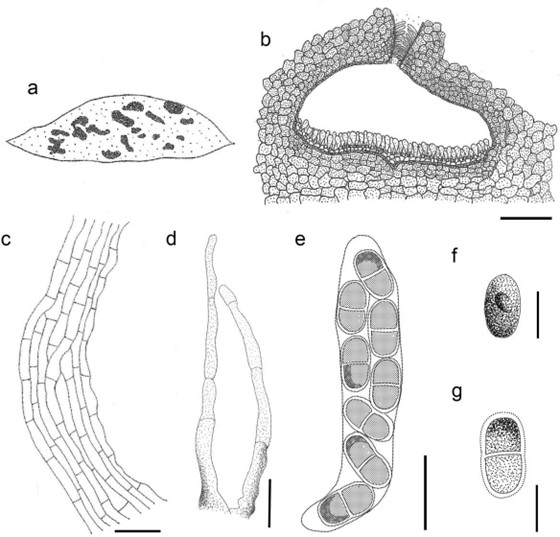Phaeochorella (Henn.) Theiss. & Syd., Ann Mycol 13:405. 1915.
Index Fungorum number: IF 3899; MycoBank number: MB 3899; Facesoffungi number: FoF 06857; 2 morphological species (Guterres et al. 2019), 1 species with sequence data.
Type species – Phaeochorella parinarii (Henn.) Theiss. & Syd.
Notes – Phaeochorella, typified by P. parinarii, was initially accommodated in several families, viz. Phacidiaceae, Phyllachoraceae and Polystigmataceae (Theissen & Sydow 1915, Müller & von Arx 1973). It was then maintained in Phyllachoraceae, Phyllachorales (Cannon 1991) until now, where it has finally been transferred to a new family, Phaeochorellaceae (Guterres et al. 2019). The type species is a synonym of the basionym, Cocconia parinarii, reported on the leaves of Parinari curatellifolia (Hennings 1901), and its asexual morph was initially recognised as Phomachorella parinarii, reported from Pa. capensis (Petrak 1947c). However, this was reported as a misidentification since it was observed that P. parinarii produces both micro- and macro-conidia while no macroconidia were seen in “Phomachorella parinarii” (Swart 1965). Conidia of “Phomachorella parinarii” also originated from the basal layer of the stroma and were surrounded by slimy material, while conidia produced by P. parinarii were produced from all over the surface of the stroma cavity and formed a powdery conidial mass. It was concluded that the conidia observed by Petrak were from another fungus parasitizing the stroma of P. parinarii (Swart 1965).
Phaeochorella originally comprised five species, namely, P. parinarii, P. zonata, P. artocarpi, P. ciliata, and P. machaerii, which originated from tropical regions (Theissen & Sydow 1915, Petrak 1947c, Ramakrishnan & Ramakrishnan 1948, Batista & Peres 1960, Batista & Bezerra 1961). However, at present, the genus comprises only P. parinarii and P. zonata (Guterres et al. 2019). Phaeochorella machaerii is now considered a synonym of Phyllachora puncta, while P. ciliata and P. artocarpi comprise bitunicate asci and ascospores without any equatorial hyaline band (Guterres et al. 2019). Auerswaldia clypeata was also placed in Phaeochorella and synonymised with Phaeochorella clypeata, but it was subsequently excluded from the genus based on ascospore morphology (Theissen & Sydow 1915, Petrak 1947c). Similarly, Phaeochorella sphaerospora was not accepted as a species belonging to Phaeochorella but recognised as synonym of Phyllachora conica since ascospore colour was considered insufficient to differentiate between the two species (Cannon 1991). The holotype of P. sphaerospora was, however, not examined since it was apparently lost, and thus, only the colour of the ascospores was deemed as an insufficient character to differentiate between the two species (Cannon 1991).

Figure 193 – Phaeochorella parinarii (epitype UB Mycol. Coll. 23270, redrawn from Guterres et al. 2019). a Pseudostromata on leaf of Parinari obtusifolia. b Immersed perithecial ascoma with a periphysate ostiole. c Peridium comprising cells of textura prismatica. d Septate paraphyses. e Ascus containing mature ascospores with typical subhyaline equatorial band. f, g Immature and mature ascospores. Scale bars: a = 2 cm, b = 100 µm, c, d = 20 µm, e-g = 10 µm
Species
Phaeochorella parinarii
